|

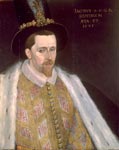 James VI is regarded as one of Scotland's most successful monarchs, despite ruling the country for over twenty years from another country. Part of the reason for his success was the longevity of his reign, the longest for a Stewart king: 58 years. During this time he was able to suppress the rebelling lords who had risen against him and also contain the more zealous members of the church. Despite going on to order the creation of the English translation of the Bible once in England, James' rule is also associated with what is seen now as less Christian behaviour: his attitude to the Highlands and Ireland and particularly his persecution of suspected witches. He believed that witches had summoned a storm intended to kill him and his bride Anne of Denmark while they attempted to return to Scotland. James VI is regarded as one of Scotland's most successful monarchs, despite ruling the country for over twenty years from another country. Part of the reason for his success was the longevity of his reign, the longest for a Stewart king: 58 years. During this time he was able to suppress the rebelling lords who had risen against him and also contain the more zealous members of the church. Despite going on to order the creation of the English translation of the Bible once in England, James' rule is also associated with what is seen now as less Christian behaviour: his attitude to the Highlands and Ireland and particularly his persecution of suspected witches. He believed that witches had summoned a storm intended to kill him and his bride Anne of Denmark while they attempted to return to Scotland.
Kingdome of Scotland
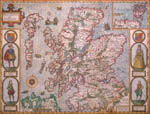 The outline of the country during James VI's reign is based on an earlier map of 1595 by the great Flemish map-maker, Gerard Mercator. While the north and east coasts are recognisable, representation of the west coast was sadly awry. Produced in London 7 years after the Union of the Crowns of Scotland and England under James VI and I, its creator, John Speed (1552-1629), included small vignettes of King James, Queen Anne, and their sons Henry and Charles (later Charles I) on the map. The map appeared in 1611 in the first printed atlas of the British Isles, John Speed's 'Theatre of the Empire of Great Britaine'. In contrast to the county and province maps of England, Wales and Ireland present, it was the only map of Scotland included. The outline of the country during James VI's reign is based on an earlier map of 1595 by the great Flemish map-maker, Gerard Mercator. While the north and east coasts are recognisable, representation of the west coast was sadly awry. Produced in London 7 years after the Union of the Crowns of Scotland and England under James VI and I, its creator, John Speed (1552-1629), included small vignettes of King James, Queen Anne, and their sons Henry and Charles (later Charles I) on the map. The map appeared in 1611 in the first printed atlas of the British Isles, John Speed's 'Theatre of the Empire of Great Britaine'. In contrast to the county and province maps of England, Wales and Ireland present, it was the only map of Scotland included.
The Honours of Scotland (Crown and bonnet)
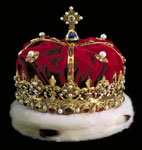 The Honours of Scotland or Scotland's Crown Jewels are the oldest sovereign regalia in the United Kingdom. The Crown was used to crown the legitimate monarch of Scotland. The regalia were first used together at the enthronement of the infant Mary, Queen of Scots at Stirling Castle in 1543, and also at the coronation of her infant son James VI in 1567. They were last used in the coronation of Charles II in 1651. The Honours of Scotland or Scotland's Crown Jewels are the oldest sovereign regalia in the United Kingdom. The Crown was used to crown the legitimate monarch of Scotland. The regalia were first used together at the enthronement of the infant Mary, Queen of Scots at Stirling Castle in 1543, and also at the coronation of her infant son James VI in 1567. They were last used in the coronation of Charles II in 1651.
Now situated in Edinburgh Castle, they have had an extraordinary history, having been the subject of several adventures in the last 500 years. They were hidden during Cromwell's occupation of Scotland, and had to be smuggled out of Dunottar Castle to prevent their discovery and destruction.
They were secured in Edinburgh Castle under the terms of the 1707 Act of Union and were discovered in a chest in the walled-up Crown Room by Walter Scott in 1818, where they had lain unseen for 111 years. One of the first people to see them was King George IV on his visit to Scotland in 1822. The Honours were hidden during the Second World War as a precautionary measure in case of German invasion.
James portrait
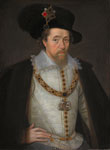 James ruled Scotland shrewdly and successfully for many years. He was still a baby when he was crowned King of Scots after his mother's forced abdication in 1567, and his troubled childhood, disturbed by the machinations of the ambitious nobility, made him all the more delighted to move south in 1603 to London, where his prestige, as well as his personal security, were greatly increased. James ruled Scotland shrewdly and successfully for many years. He was still a baby when he was crowned King of Scots after his mother's forced abdication in 1567, and his troubled childhood, disturbed by the machinations of the ambitious nobility, made him all the more delighted to move south in 1603 to London, where his prestige, as well as his personal security, were greatly increased.
He liked to boast that he thereafter ruled Scotland with the stroke of his pen, and indeed his knowledge of his own countrymen allowed him to govern effectively from more than four hundred miles away. Scotland retained its own parliament and legal system, but James did what he could to encourage a more completed union of his two kingdoms.
James VI bible
 This is the frontispiece of a King James Bible published in 1611. This version, translated and published first in 1611, became one of the most influential books in the English language. The frontispiece has an ornate border with various figures. Forty-seven revisers, drawn from the eminent theologians of the day, worked on translating the bible for four years. Earlier translations were coordinated with Hebrew, Greek and Latin texts. The King James version remained the authorised translation until 1881 when newly discovered texts were incorporated. This is the frontispiece of a King James Bible published in 1611. This version, translated and published first in 1611, became one of the most influential books in the English language. The frontispiece has an ornate border with various figures. Forty-seven revisers, drawn from the eminent theologians of the day, worked on translating the bible for four years. Earlier translations were coordinated with Hebrew, Greek and Latin texts. The King James version remained the authorised translation until 1881 when newly discovered texts were incorporated.
Witches' Stone, Forres
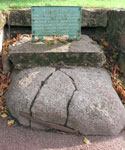 During the witch mania that struck Scotland during the reign of James VI, witches were executed in Forres by bending the accused double into barrels filled with tar, which were then rolled down Cluny Hill. Where they stopped, the barrels were burned with the women inside. This stone supposedly marks the spot where one of the barrels came to rest. It is situated on the pavement just outside the police station, which itself is at the foot of Cluny Hill. During the witch mania that struck Scotland during the reign of James VI, witches were executed in Forres by bending the accused double into barrels filled with tar, which were then rolled down Cluny Hill. Where they stopped, the barrels were burned with the women inside. This stone supposedly marks the spot where one of the barrels came to rest. It is situated on the pavement just outside the police station, which itself is at the foot of Cluny Hill.
James VI was obsessed by witchcraft and in 1600 he fell ill at Scone having visited Forres previously. His illness was attributed to black magic, an investigation was launched and a coven was found in the act of melting a wax image of the king. They were duly tried and executed in the above manner.
|

















